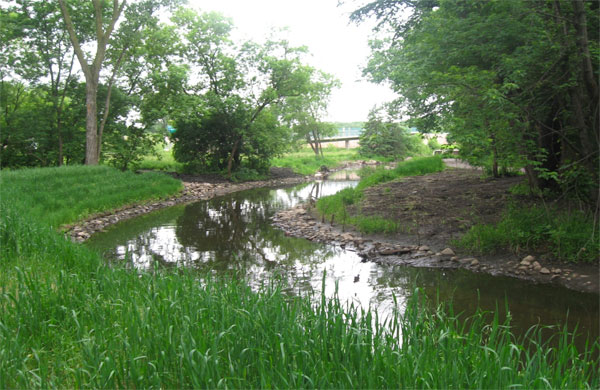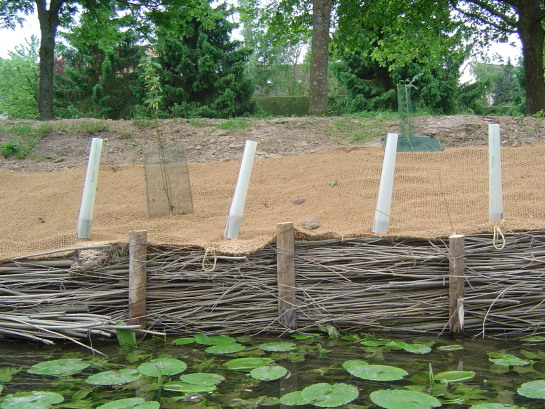Riverbank represents both natural and artificial terrain following the river flow. In the past, lots of artificial banks were built with concrete or other types of retention walls, therefore limiting rivers’ natural movements, leading to degradation of the river, increased water flow, increased erosion and decreased biodiversity. River bank renaturalisation consists in recovering its ecological components, thus reversing such damages and especially allowing bank to be stabilized, as well as rivers to move more freely. Nature-based solutions such as bioengineering are preferable, but civil engineering has to be used in case of strong hydrological constraints.
 |
 |
|
Bank stabilisation with stones (USA) Source: http://www.goldenvalleymn.gov/surfacewater/stream-bank-stabilization.php |
Bank stabilisation with wood weaving (France) |
| Benefits | Level |
|---|---|
|
BP1 - Store runoff
|
Low
|
|
BP2 - Slow runoff
|
Low
|
|
BP3 - Store river water
|
Low
|
|
BP4 - Slow river water
|
Medium
|
|
BP5 - Increase evapotranspiration
|
Medium
|
|
BP6 - Increase infiltration and/or groundwater recharge
|
Low
|
|
BP7 - Increase soil water retention
|
Medium
|
|
BP8 - Reduce pollutant sources
|
Low
|
|
BP9 - Intercept pollution pathways
|
Medium
|
|
BP10 - Reduce erosion and/or sediment delivery
|
High
|
|
BP11 - Improve soils
|
High
|
|
BP12 - Create aquatic habitat
|
High
|
|
BP13 - Create riparian habitat
|
High
|
|
BP14 - Create terrestrial habitats
|
Low
|
|
BP16 - Reduce peak temperature
|
Low
|
|
BP17 - Absorb and/or retain CO2
|
Low
|
|
ES1 - Water storage
|
Low
|
|
ES2 - Fish stocks and recruiting
|
High
|
|
ES3 - Natural biomass production
|
High
|
|
ES4 - Biodiversity preservation
|
High
|
|
ES5 - Climate change adaptation and mitigation
|
Low
|
|
ES6 - Groundwater/aquifer recharge
|
Low
|
|
ES7 - Flood risk reduction
|
Medium
|
|
ES8 - Erosion/sediment control
|
High
|
|
ES9 - Filtration of pollutants
|
High
|
|
ES10 - Recreational opportunities
|
High
|
|
ES11 - Aesthetic/cultural value
|
High
|
|
PO1 - Improving status of biology quality elements
|
High
|
|
PO2 - Improving status of physico-chemical quality elements
|
Medium
|
|
PO3 - Improving status of hydromorphology quality elements
|
High
|
|
PO4 - Improving chemical status and priority substances
|
Medium
|
|
PO5 - Improving quantitative status
|
Low
|
|
PO6 - Improving chemical status
|
Low
|
|
PO7 - Prevent surface water status deterioration
|
High
|
|
PO8 - Prevent groundwater status deterioration
|
Low
|
|
PO9 - Take adequate and co-ordinated measures to reduce flood risks
|
Medium
|
|
PO10 - Protection of important habitats
|
High
|
|
PO11 - Better protection for ecosystems and more use of Green Infrastructure
|
High
|
|
PO12 - More sustainable agriculture and forestry
|
High
|
|
PO13 - Better management of fish stocks
|
High
|
|
PO14 - Prevention of biodiversity loss
|
High
|
